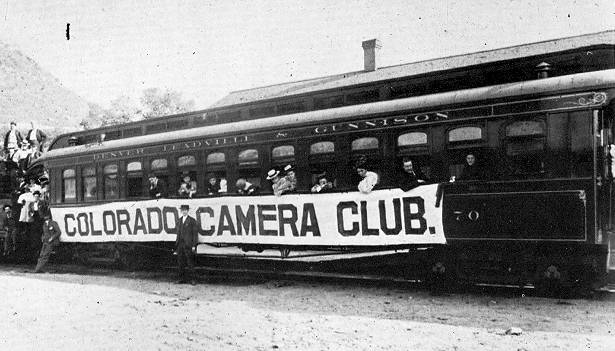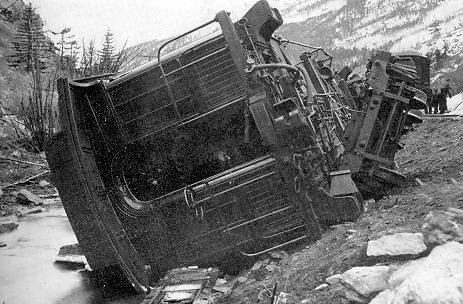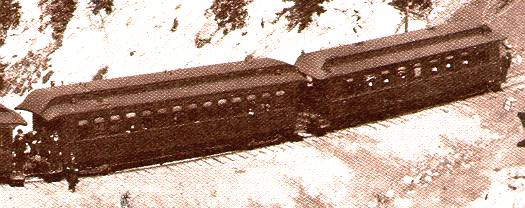Coaches #27 and #28
|
 |
|
(2) DL&G coach #70 at Garfield Quarry, 1892. Notice the panels between the windows, allowing for only 14 windows on an almost 42' car. F.E. DuBois photo at Digerness1-130. (Click pic for enlargement.) |
 |
|
(3) Unusual end view of same car (now C&S #164) near Grant, 1906. Note the Janney knuckle coupler with a slot for connection to a link-and-pin. H.G. Jones photo at Digerness2-54(d) and Kindig-157(d). (Click pic for enlargement.) Broader view is at Kindig-157(u). |
HISTORY
Coaches #27 and #28 were received from the Union Pacific in October 1884. They may have been built by Pullman, as they apparently came with 30" wheels, and wheels that large were a Pullman trait. The highline had been completed to Leadville in February, but snow soon blocked traffic over Boreas and Fremont passes, forcing the South Park to revert to using the Rio Grande’s tracks. But even that line was having major problems.
Then in March a disastrous avalanche came down the slopes of the Palisades on the west side of Alpine Pass, utterly destroying the town at Woodstock.
Spring melting of the heavy snow further damaged the newly laid track, and crews were at work all summer and well into the fall. It was September before the first train operated over the new route.
But the policies of the Union Pacific during previous years had alienated many shippers, and they were not anxious to switch allegiance from the Rio Grande. In addition, the silver boom at Leadville had peaked, so there was little new traffic. The South Park would not be able to pay even the interest on its bonds that year (1884). It seems like an odd time for the South Park to be getting new cars, but perhaps there was optimism in September that traffic would develop.
This odd timing may be the reason some authorities believe these cars were received in 1886 rather than 1884. But the fact is that they were on the roster for renumbering by the U.P. in June of 1885. (Unless, of course, this is one of the “obvious” errors Ehernberger says were corrected in his publication of the list.)
These cars had hardly been put into service before they were assigned new numbers by the Union Pacific. Coach #27 became #70 and coach #28 became #71. The cars kept these numbers under the Denver, Leadville & Gunnison reorganization in 1889, and—from the looks of the first photo above—may have received a new coat of paint (at least #70 did). (Query: where did a bankrupt railroad get the money to repaint so many cars???)
From the looks of the available photos, these “new” cars seem to have become the mainstay of South Park operations.
In 1899, when they passed to the Colorado & Southern, coach #70 became C&S #174 and coach #71 became C&S #175. In 1906 they were renumbered #80 and #81.
Coach #80 was rebuilt by the C&S in 1915.
Coach #81 was rebuilt in early 1923, just before being sold to the Herr-Rubicon Supply Company (February 1923).
Coach #80 was used until October 1929, when it was dismantled along with a number of other C&S narrow gauge cars.
